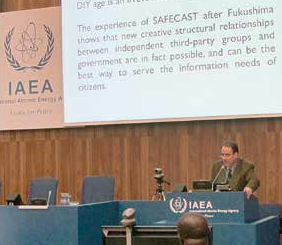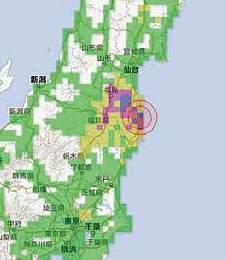Issue:
What happens when a group of radiation-detecting hackers is asked to speak to the IAEA?
The initial contact came last summer. It was a polite email informing Safecast that an International Atomic Energy Agency (IAEA) expert meeting dealing with the Fukushima accident would be held in Vienna in Feb., 2014; it would pay particular attention to “public communication and stakeholder involvement.” Would we consider making a presentation about our radiation monitoring work?
While Safecast doesn’t have much in the way of official or academic credentials, we are proud of what we have accomplished. What started as an anxious international web chat between Joi Ito, Pieter Franken and Sean Bonner in the days following 3/11 has grown into a loose-knit but effective group of citizen-scientist volunteers on several continents.
We’ve created no fewer than seven increasingly full-featured and compact mobile radiation detector (Geiger counter) designs, and built a database with over 16 million discrete GPS-tagged radiation measurement points, all of which are accessible through state-of-the art web and smartphone maps. Everything is open to anyone to use, free of charge and free to use under a Creative Commons CC0 license. In response to the acute vacuum of information about radiation levels after the Fukushima disaster, our response was to do it ourselves, and to teach others how to do it too.
WALKING A FINE LINE
People on all sides of the nuclear power debate have pointed to Safecast as a source of unbiased information. This credibility derives in part from the group’s technical skill, but equally from a jealously guarded independence. As we are forced to repeat time and again, we are not an anti-nuclear group, nor are we pro-nuclear.
We have no political agenda. We are pro-data and pro-openness, and believe people should be aware of what's going on in their environments and involved in gathering and sharing information about it. Our radiation-mapping work after Fukushima has been a de-facto criticism of Japanese government efforts, but we spend little time criticizing and a lot trying to set a better example.
Because of this, the IAEA invitation sparked an internal discussion as we clarified for ourselves what group goals would justify our participation. In the end, we saw it as an opportunity to open up the debate within the regulatory agencies themselves; to call attention to what citizen scientists who make use of a new generation of low-cost tools and technologies can now accomplish; and to see if we couldn't help set the bar higher for clear, timely communication of radiation and other environmental hazards. We said yes.
Born in the wake of President Dwight Eisenhower's famous “Atoms for Peace” speech given at the UN in 1953, the IAEA from the outset has carried multiple and sometimes conflicting briefs. It is simultaneously called on to support and enable peaceful uses of nuclear technology, prevent the proliferation of nuclear weapons, and promote nuclear safety around the globe. Many observers consider non-proliferation to be the agency’s most important mission, and give it high marks in this area overall, while acknowledging failures of varying degrees in cases such as Libya, Pakistan, Iran, and North Korea.
And as far as nuclear power is concerned, critics frequently point out that any agency that supports the expansion of an industry will find it difficult to also be its primary regulator. Not many people realize that the IAEA actually has no enforcement power. It can report nuclear weapons violators to the UN Security Council, which can then decide on sanctions, but it cannot force a country to improve the safety of its nuclear power plants. It can make recommendations, which carry weight in and of themselves, but cannot punish violators.
HINDERED BY RED TAPE AND RESISTANCE
Further, the IAEA can only act at the behest of member states. Powerful members can provide funding for preferred programs, discourage others, and influence the agenda in many ways. Finally, over the years a labyrinthine process of consultation and recommendation has evolved among the IAEA and other international agencies like the ICRP, WHO, and UNSCEAR, and regulatory agencies of the member states, like the NRC and DOE in the U.S. Decision making can be glacial, and proponents of change must usually overcome stubborn institutional resistance. Even those who support this system will admit that it is highly politicized and suffocatingly bureaucratic.
Even if a group of uncredentialed hackers like us were invited in, there was little precedence to presume our appearance would make a difference. After the Chernobyl disaster, the IAEA and its partner agencies embarked on an extensive review of policies and procedures. New guidelines were developed for protecting the health and welfare of populations, new protocols were worked out for prompt international notification of nuclear accidents, new international and interagency agreements codified in writing who was supposed to do what and when in the case of an accident, and all of this was regularly tested and rehearsed over two decades.

Yet, when Fukushima Daiichi melted down, almost none of it worked like it was supposed to. Most importantly, the IAEA failed to promptly inform the global public of the severity of the situation, waiting four days before giving its first press conference. These failures have been chronicled and dissected at length, but it appeared that a few people in these agencies had watched with admiration and envy as Safecast rapidly built a grass-roots organization with impressive technical capabilities and communications savvy. They wanted to know how we had earned the public’s trust while the IAEA and Japanese government had lost it. And they were hoping we would shake things up in a way they themselves couldn’t.
Still, there were hurdles. Insiders hint-ed of people with influence who might prefer we not be given the chance to speak, either because of the criticisms we might voice or simply because we’re not part of the academic establishment. It was also suggested that our usual snarky and flippant style of communication, which works well in a social media context, was as likely to alienate an audience of experts as entertain it, particularly if Japanese delegates felt ridiculed. We spent a fair amount of time preparing and polishing our presentation before Joe Moross, a Safecast radiation detector designer with over 30 years experience, and I made our way to Vienna.
Our slot was late in the afternoon of the second day, when people are likely to be tired and a bit cranky. After softening up the 200+ audience with filmmaker Adrian Storey’s short video about Safecast, I explained our organization, methodology, and guiding principles. I described our hardware and design guidelines. I compared the quality and quantity of the radiation data in our maps to what the Japanese government provides, and let the images speak for themselves.
THE BENEFITS OF CROWDSOURCING
Finally, I told everyone that the genie is out of the bottle, that soon everyone will have these capabilities actually a good thing and not something to be feared. I suggested that the best official response would be to streamline their own data collection and dissemination processes, and make them more transparent, and to allow citizens’ groups like Safecast to operate unhindered. When data becomes available from many different sources, people will be able to compare it, and as in most crowdsourcing efforts, the best data will survive scrutiny.
During the following Q&A, many questions were raised about the calibration of our devices, about how we guard against malicious data, how we ensure the safety of our volunteers, and yes, about our credentials. The skeptics were raking us over the coals. At one point, however, a representative from Norway leapt to our defense, telling the doubters that they were missing the big picture, that, “If an accident happens in your country you'll be lucky to have people like this!”
At that the room burst into applause, and we could feel the consensus shift solidly to our side. Afterward, we were approached by several people who told us that they had been skeptical, but were now convinced and intended to spread the word. A couple of attendees even asked us to sell them our bGeigie detectors right then and there.
‘OUR RADIATION-MAPPING WORK AFTER FUKUSHIMA HAS BEEN A DE-FACTO CRITICISM OF JAPANESE GOVERNMENT EFFORTS, BUT WE SPEND LITTLE TIME CRITICIZING AND A LOT TRYING TO SET A BETTER EXAMPLE.
The Chairman’s report of the meeting, IEM6, includes a clear acknowledgement of our principles, admonishing government authorities and agencies to disseminate timely information as widely as possible. And though the tone is typical IAEA-speak there is some language that is clearly from our presentation:
“For government authorities and agencies, crowdsourcing certainly is the ‘genie that will not go back in the bottle.’ It is necessary to accept that this technology is here to stay and that empowerment of the public is not necessarily a negative development.”

If the tone is as unthreatening to member states as possible, the intent is clear: the presence of active and independent watchdogs will encourage everyone to do their jobs better. At the moment, it is just a paragraph in a report, but its inclusion there allows it to be put on the agenda for discussions shaping the next revisions of protection guidelines. We feel this language sets an important precedent for the acceptance of independently gathered radiation data.
In the case of Safecast, the data is about environmental radiation, but in principle independent data about food contamination or health screening should also be encouraged and protected. Most importantly, the statement encourages countries to allow independent groups to form, and to protect their independence. Even if these recommendations become actual advisory guidelines, however, it might not presage as big a change as we might hope.
HOPE AND DOUBTS, SIDE BY SIDE
As mentioned earlier, the IAEA cannot enforce its guidelines. Safecast's techniques and methodologies are teachable and scalable, but we also benefited from an optimum combination of talents, nonideological principles and ethics, and not every group that forms in the future will necessarily repeat this. If groups start publicizing lousy data (and some already do), the whole thing could backfire. We could also imagine some governments propping up groups that look similar but that are really not independent, further damaging trust. Nevertheless, we think a giant step has been taken and we couldn't have hoped for a better outcome.
Our criticisms of the IAEA stand. Their structural problems continue to make it difficult for the primary regulatory agencies to respond quickly and adequately to new information, specifically concerning health risks from radiation. There is a status quo, and it is resistant to change, and colleagues who have tried to make important revisions to protection guidelines after Chernobyl tell hair-raising stories of stonewalling, duplicity, bad faith and prevarication.
Yet I have less doubt about the seriousness and motivation of the people on the front lines. Much of our audience was made up of the emergency responders, the ones who are prepared to put themselves in harm’s way to gather radiation data when the next emergency arises, the ones who really have a need for tools like our bGeigie. I see that there are reformers at work, lobbying, writing, reporting, and finding allies. Disasters are like wars in that we’re always prepared for the last one, but true preparedness requires agility and resilience. These are guiding principles at Safecast, and if our culture is starting to find a wider foothold, then I think we can claim a new measure of success.
Azby Brown is the director of the KIT Future Design Institute, author of several books on Japanese architecture and design and a Safecast volunteer since 2011.

